| In a clinical
trial involving 24 patients with hypertrophic obstructive cardiomyopathy,
pilsicainide (a pure Na channel-blocker) was compared with propranolol,
verapamil, disopyramide, and cibenzoline. Pilsicainidefs efficacy
in reducing left ventricular pressure gradient equaled that
of dysopyramide and cibenzoline. The Na-channel blocking effect
predominantly leads to reduce left ventricular pressure gradient
(LVPG) compared with beta-blocking agent and Ca-channel blocker.
Dr. Imai explained that although various drugs
with negative inotropic effects have been used in hypertrophic
obstructive cardiomyopathy (HOCM) to reduce the left ventricular
pressure gradient (LVPG), few data exist to help physicians
choose an agent for the individual patient.
The purpose of the current clinical trial was to compare
pilsicainide, a pure Na channel-blocker, with 4 drugs that
have some degree of proven efficacy in reduction of LVPG:
propranolol (a beta-blocker), verapamil (a Ca channel-blocker),
disopyramide (a class 1a antiarrhythmic), and cibenzoline
(another class 1a antiarrhythmic). The patient population
was to consist of adults with proven HOCM and LVPG without
provocation of greater than 40 mm Hg.
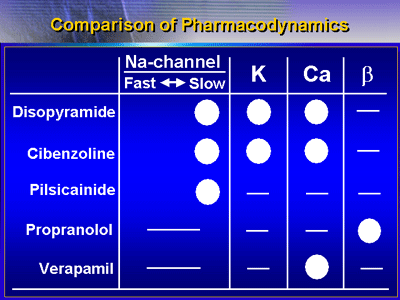
All 24 participants had baseline left ventricular (LV) function and LVPG assessments, and then they were divided into 2 groups of 12 patients each. The first group (Group A, mean LVPG 84.5}28.5 mmHg) was used to evaluate the effects of propranolol, verapamil, and disopyramide. The other group (Group B, mean LVPG 92.5}40.3 mmHg) was used to evaluate the effects of pilsicainide, disopyramide, and cibenzoline.
Patient Characteristics
| |
Group
A
(N=12 patients)
DSP vs. PRP
vs. VRP |
Group
B
(N=12 patients)
DSP vs. CBZ
vs. PLS |
| Age (mean) |
48.2 } 15.2
years |
53.5 } 18.6
years |
| Gender (male/female) |
5 / 7 patients |
4 / 8 patients |
| LVOT PG (mean) |
84.5 } 28.5
mmHg |
92.5 } 40.3
mmHg |
| IVS/PW (mean) |
19.5 } 10
/
14.1 } 4.4 mm |
25.0 } 7.0
/
14.1 } 2.0 mm |
| ASH |
10 patients
(83%) |
11 patients
(92%) |
| SAM |
9 patients
(75%) |
10 patients
(83%) |
| MR (mild) |
9 patients
(75%) |
11 patients
(92%) |
DSP: Disopyramide
PRP: Propranolol
VRP: Verapamil
CBZ: Cibenzoline
PLZ: Pilsicainide |
|
Patients received before-treatment and after-treatment
evaluations for each of the 3 drugs they tested. Echocardiography
was used to assess LVPG, percent fractional shortening (%FS),
peak E/A wave ratio (E/A ratio), isovolumic relaxation time
(IRT), and deceleration time (DcT). Each drug was given intravenously
as follows: disopyramide (1.2mg/kg), cibenzoline (1.4mg/kg),
pilsicainide (1.0mg/kg), verapamil (0.1mg/kg), and propranolol
(0.2mg/kg).
In testing with the first group of patients (Group A), disopyramide
was clearly superior to verapamil and propranolol in reduction
of LVPG. In testing with the second group of patients (Group
B), disopyramide, cibenzoline, and pilsicainide had roughly
equivalent effects on LVPG (-55.5}28.0% with disopyramide
[from 92.5 to 40.3 mm Hg], -58.5}21.3% with cibenzoline [from
103.1 to 44.4 mmHg], -54.5}15.5% with pilsicainide [from 107
to 47.5 mmHg]).
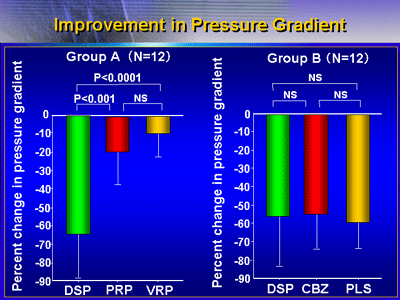
The other parameters that were measured were percent fractional
shortening (%FS), peak E/A wave ratio (E/A ratio), isovolumic
relaxation time (IRT), and deceleration time (DcT). In contrast
to the effects of propranolol and verapamil, the effects of
the three class 1 antiarrhythmic agents (pilsicainide, disopyramide,
cibenzoline) were similar and without statistical significance:
Percent fractional shortening was significantly decreased,
E/A ratio was significantly increased, and DcT was significantly
prolonged.
Comparative Results for
All 5 Drugs
[A-Group]
| |
Disopyramide |
Propranolol |
Verapamil
|
| |
Pre |
Post |
Pre |
Post |
Pre |
Post |
| E/A |
1.15}
0.59 |
1.49}
0.50 |
0.93}
0.37 |
0.97}
0.45 |
1.13}
0.41 |
1.26}
0.40 |
| (p<0.005)
|
(p=0.4) |
(p=0.2) |
| DcT(msec) |
223}
33 |
244}
30 |
204}
26 |
200}
23 |
228}
43 |
215}
45 |
| (p=0.01)
|
(p=0.4)
|
(p=0.1)
|
| IRT (msec)
|
71.5}
13.5 |
88.7}
10.6 |
70.0}
7.6 |
68.1}
10.7 |
77.5}
15.1 |
74.4}
15.5 |
| (p<0.0001)
|
(p=0.4) |
(p=0.3)
|
| %FS(%) |
41.5}
2.9 |
35.6}
3.2 |
39.3}
5.7 |
37.3}
0.3 |
39.6}
5.8 |
41.3}
4.4 |
| (p<0.0001) |
(p=0.07) |
(p=0.2)
|
[B-Group]
| |
Disopyramide |
Cibenzoline |
Pilsicainide |
| |
Pre |
Post |
Pre |
Post |
Pre |
Post |
| E/A |
1.22}
0.02 |
1.83}
0.76 |
1.17}
0.47 |
1.69}
0.54 |
1.49}
0.80 |
2.31}
1.25 |
| (p<0.005) |
(p<0.005) |
(p<0.0005)
|
| DcT(msec) |
208}
38 |
231}
31 |
211}
28 |
236}
31 |
215}
36 |
244}
32 |
| (p<0.05) |
(p<0.05) |
(p<0.0005)
|
| IRT (msec)
|
58.9}
11.7 |
71.7}
14.1 |
61.1}
13.0 |
72.8}
16.0 |
56.0}
7.5 |
73.3}
11.2 |
| (p<0.0001)
|
(p<0.005)
|
(p<0.0001) |
| %FS(%) |
43.4}
4.5 |
35.0}
4.9 |
43.6}
4.3 |
37.2}
5.4 |
43.0}
4.2 |
35.7}
4.4 |
| (p<0.0001) |
(p<0.0005) |
(p<0.0001)
|
|
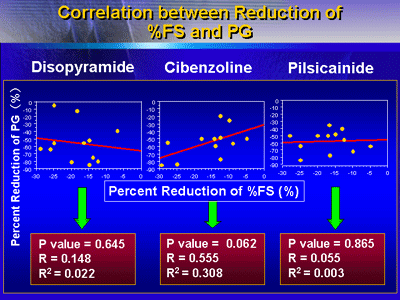
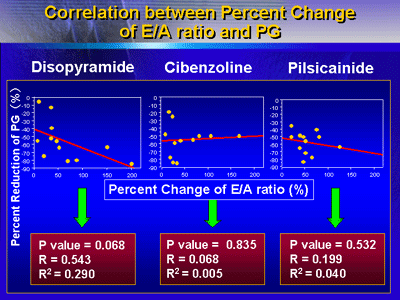
Dr. Imai concluded that the efficacy for reduction of LVPG by pilsicainide (the pure Na channel-blocker) is comparable with that of the other class 1 antiarrhythmic agents, disopyramide and cibenzoline. In contrast, the sample beta-blocker and Ca channel-blocker (propranolol and verapamil) have a variety of effects other than reduction in LVPG in this population of patients with HOCM.
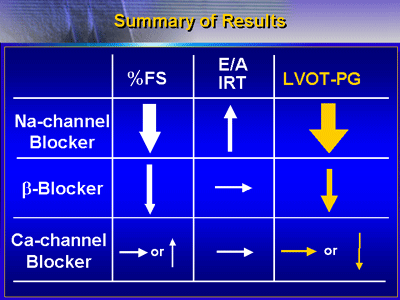
@ |